Archive for the 'FILM ART (the book)' Category
Not back to the future, but ahead to the past
From DB:
Whatever you think of his films, Steven Soderbergh keeps Hollywood lively. Anybody who can remake both Solaris and Ocean’s Eleven has to attract your attention. He’s created at least three films I admire: Out of Sight (brilliant effort at a novelistic structure onscreen); The Limey (but I wish it were longer); and The Underneath (underrated, especially by its director).
So when Brian Rose and Paul Ramaeker sent me “You Can Make ‘Em Like They Used to,” by the ever-reliable Dave Kehr, I had to offer my two cents. You may want to check it before it evaporates into the Times pay-for-access archive. In a nutshell, Soderbergh’s The Good German is the most thoroughgoing effort by an American director to reproduce the look and feel of a 1940s movie. For me, Dave’s piece raises a lot of intriguing questions about how accurately you can reproduce an earlier style today.
RetroClassicism
During the production Mr. Soderbergh was committed to remaining as true as possible to the technique of the era. By reproducing the conditions of an actual studio shoot from the late 1940s, he hoped to enter the mind of a filmmaker like Mr. [Michael] Curtiz, to explore the strengths and limitations of a classical style that has now largely been lost.
This project hooks up with some arguments I made in The Way Hollywood Tells It. For one thing, I suggested that the overall “classical” style of Hollywood, founded on a certain conception of cinematic storytelling that emerged around 1917, hasn’t been abandoned, even in the most craven items we find in our multiplexes. But of course more local changes in style, shifts in particular technical devices of camerawork or lighting or editing, have come and gone. Another book I worked on, with Janet Staiger and Kristin Thompson, The Classical Hollywood Cinema, tries to trace some of the stylistic variations within the classical tradition. We covered topics like the development of deep-focus cinematography in the 1940s–just the sort of period-based technical choices that Soderbergh is trying to recapture.
Another theme of The Way is interestingly confirmed by Dave’s article. Some historians have argued that we’ve entered a “post-classical” era in which classical storytelling principles have been abandoned. I tried to show that in fact many of our filmmakers, like Cameron Crowe and Martin Scorsese, have the utmost admiration for the studio filmmaking tradition and define themselves as heirs and continuers of it. Spielberg said that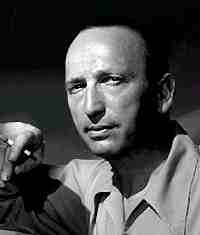 he’d like to be the Victor Fleming of our era; now Soderbergh has a new model.
he’d like to be the Victor Fleming of our era; now Soderbergh has a new model.
“I often think I would have been so happy to be Michael Curtiz [on right],” Mr. Soderbergh said. Mr. Curtiz, the contract director, made more than 100 films for Warner Brothers, including Casablanca and Yankee Doodle Dandy , between his arrival in Hollywood from Hungary in 1926 and his death in 1962. “That would have been right up my alley,” Mr. Soderbergh said, “making a couple of movies a year of all different kinds, working with the best technicians. I would have been in heaven, just going in to work every day.”
Today most directors carry forward the basic premises of the overall classical style quite spontaneously. A few do so in fuller awareness of that tradition, and several of those think about how they can enlarge, deepen, vary, or otherwise add to the heritage that they respect. Evidently The Good German is an example of this last tendency.
Through a Ground Glass Darkly
Take a deep breath. Some gearhead stuff coming. But interesting gearhead stuff.
“We set up our little guidelines,” [Soderbergh] said. For one, he banned the sophisticated zoom lenses that make life easier for today’s cinematographers, returning to the fixed focal-length lenses of the past. “I did some research and found some script continuities for a couple of Michael Curtiz films,” he recalled, referring to records of the lens and exposure used in every shot, in case retakes were necessary. “I found that he restricted himself to at most five lenses, usually three or four. I talked to Panavision, and they happened to have some older lenses that they’d made that didn’t have all the new coatings on them and also were a focal length that isn’t really used anymore. One of them was a 32 millimeter, a wide-angle lens that nobody uses anymore but was one that Curtiz used a lot.”
Wide-angle lenses have short focal lengths. As the name implies, they take in a wider field of view than lenses of longer focal lengths. They tend to distort vertical lines and make faces look puffy, so they weren’t recommended for medium-shots or close-ups. That was a task for lenses of “normal” lengths. It’s an interesting fact of film history, though, that over time the conception of a normal lens has changed.
In the silent era, the most commonly used lens seems to have been the 50mm, the classic “two-inch” lens. It was taken to be close to normal human vision. But by 1950, 35mm had become the default lens. Why? This wider-angle lens could be used easily on location and in the smaller sets mandated by wartime restrictions. Improvements in lighting, lens coatings, and film stock made the lens of short focal length more feasible. The Good German is set in the late 1940s, and Soderbergh has plugged into a general trend of filmmaking of that time
These lenses allowed directors to stage in greater depth, pushing foreground planes quite close to the camera and distant planes quite far back. And all the scene’s components could be in reasonable focus. After Citizen Kane, The Little Foxes, Ball of Fire, The Maltese Falcon, and How Green Was My Valley (all 1941) showcased a range of deep-focus possibilities, many cinematographers developed wide-angle styles.
They believed that the greater depth of field enhanced both realism and pictorial beauty.
Frank Planer: For Criss Cross (1949): “To give this picture added realism through photography, we filmed every scene with the 30mm lens to carry a wire-sharp depth of focus throughout the frame.” (Jack Taylor, “Dynamic Realism,” International Photographer 20, 9 (September 1948), 6.)
Russell Metty: Used 30mm lens at f/2.3 throughout Arch of Triumph (1948). (Herb A. Lightman, “‘Triumph’ in Low Key,” American Cinematographer 28, 5 (May 19447), 167.
Robert Surtees: For Act of Violence (1949), claimed to shoot all scenes with a 28mm lens “in order to carry focus and give more interesting compositions.” (Surtees, “The Story of Filming ‘Act of Violence,'” American Cinematographer 29, 9 (August 1948), 282.)
Ted McCord: For Johnny Belinda (1948), used 28mm lens almost entirely, even for medium-shots. (Herb A. Lightman, “‘Johnny Belinda,’ American Cinematographer 29, 10 (October 1948), 339.)
Many years later Stanley Cortez recalled that he had used a 30mm lens heavily for The Magnificent Ambersons (1942). (American Film Institute Seminar no. 35 (Glen Rock, NJ: New York Times/ Microfilming Corp of America, 1977), 1242-1243.)
Here are some typical examples of late 1940s wide-angle shooting from The Little Foxes, 1941; Notorious, 1946; Caught, 1949, and T-Men , 1949.
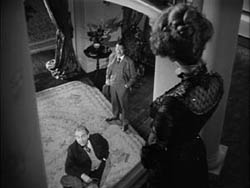
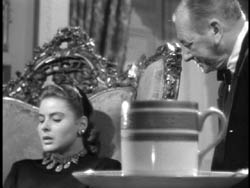
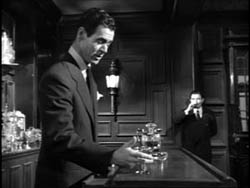
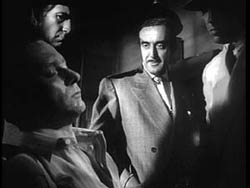
So given Soderbergh’s use of wide-angle lenses, will he try to reproduce the deep-focus look of the 1940s?
Coda for Ultimate Gearheads: The 32mm lens to which Curtiz refers was presumably the Cooke Speed Panchro lens, since I can’t find any other 32mm lens available at the time. (See Jackson J. Rose, American Cinematographer Hand Book and Reference Guide, 4th ed., American Society of Cinematographers, 1942, pp. 44-45.) Most cinematographers used the wide-angle lenses available from other companies, which were typically in the 25mm, 30mm, and 35mm ranges. Cooke, Leitz, and other firms also offered a 28mm length and a few still wider ones (25mm, 24mm, down to the Goerz 15mm!).
Another coda: The wide-angle style persisted in black-and-white filming into the 1950s and through the 1960s. It was hard to adapt to color in the 1950s, especially in the anamorphic formats like CinemaScope, but the emergence of faster color stocks made it more feasible in the 1970s. (I was reminded of this when Turner Classic Movies recently ran The Outfit (1973), with lots of neat depth shots.) The wide-angle look is occasionally revived today, notably in neo-noir, as here in The Usual Suspects.
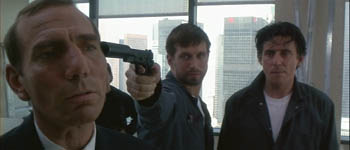
Light Waves and Sound Waves
To achieve effective depth of field, 1940s sets had to be lit at very high levels. This necessitated using the bright, hard illumination provided by arc lamps, as Gregg Toland did on Citizen Kane. Arcs, heavily used in the silent era, had been replaced by incandescent lamps in the late 1920s, because their hissing sound was picked up by microphones. “Inkies” were quieter. But once mikes became more selective, arcs were revived for Technicolor filming, and in the mid-1930s they were coming back into use for black-and-white shooting. Yet for The Good German…
They also used only incandescent lights, Mr. Soderbergh said.
Today’s actors aren’t accustomed to the blinding levels of set lighting of that period. So again, it’ll be very interesting to see if Soderberg’s inkies can provide enough depth of field to generate the flashy deep-focus of shots from the 1940s.
Wide-angle lenses also posed problems on the set. Since they took in a broader field, lighting equipment and other production gear had to be kept further back so it wouldn’t show in the frame. (Christopher Doyle told me that for the hyper-wide-angle shots of Wong Kar-wai’s Fallen Angels, crew members had to stand well behind the camera because anyone standing alongside it could wind up in the shot! Doyle’s lenses for that shoot had a focal length equal to 6.5mm!)
Moreover, 1940s wide-angle close-ups and medium-shots brought the camera within range of the microphone and other equipment. (You can hear the arc lights humming in a 35mm print of Citizen Kane, and other soundtracks of the period occasionally pick up camera or dolly noise.) Soderbergh again:
Where many, if not most, filmmakers use “body mikes” to capture the intimate whispers of dialogue, Mr. Soderbergh recorded his sound the old-fashioned way, through a boom microphone held just over the actors’ heads by a technician standing out of camera range.
“The rule was, if you can’t do it with a boom mike, then you can’t do it,” Mr. Soderbergh said. “Which was helpful to me because, in talking to the actors about this very externalized performance mode I was going to ask them to assume, it helped to be able to say, ‘You have to talk louder, you have to project more, because I’m not getting a good enough track.’ ”
I like the prospect of this whole approach, but I suspect that if 1940s filmmakers could’ve used wireless body mikes to cut camera murmur, they would have. Maybe this is a case when anachronism is welcome?
A Final Note: Staging
Dave Kehr and I have long been arguing against current filmmakers’ reliance on static staging and frantic cutting among close-ups. (Some readers took me to the woodshed on my criticism of The Departed on these grounds.) Dave and I enjoy the synthetic style of the mature sound cinema: long-take handling of actors crossing the frame and readjusting themselves in an integral space, punctuated by pointed closer views and that underrated workhorse, the spacious two-shot.
So you can practically hear Dave’s applause in this summary passage on Soderbergh’s choice of wide-angle lenses:
For audiences the shorter lenses mean a wider field of vision, expanding the camera’s range beyond the tight close-ups and two-shots that define today’s television-influenced filmmaking. With the wider range, groups of three, four or more characters can appear together on screen, minimizing the need for cross-cutting, which creates a different kind of interaction among the actors and a more expressive sense of the fictional space they inhabit.
Actually, the long lens can also create the sort of dynamic among bodies in space that we appreciate. A telephoto framing can show the interaction of several characters too. (Granted, they’re behaving in a curiously cardboardy-looking space.) We get this interaction in Altman’s 1970s films, but my favorite exponent is Hou Hsiao-hsien, who blocks his action as subtly in the distant long-lens views as classic directors did using more normal lenses.
Movies seldom turn out looking the way that the makers promised beforehand. Even the 1940s classics I litanized above don’t completely fit the cinematographers’ descriptions. Judging by the trailer for The Good German, the steep low angles and over-the-shoulder framings echo The Third Man more than, say, Jacques Tourneur’s Berlin Express.
And put aside all the fancy aggression of deep-focus. The big question is: Will Soderbergh dare to be simple as well? One production still seems promising.

I hope that Soderbergh has recognized that his mentor provided plenty of full shots with room for performers to breathe and move around. Such shots were as common, and as typical, in the 1940s as the suffocating compositions of noir. Recall this fluent passage from Mr. Curtiz’s noirish Mildred Pierce, in which characters cross the frame, shifting the compositional balance as the camera discreetly moves backward, inward, and sideways. Mildred and her husband move unobtrusively forward as the dramatic pressure rises–before it’s cut off by a crucial phone call from offscreen.
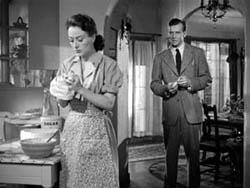
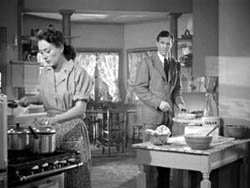

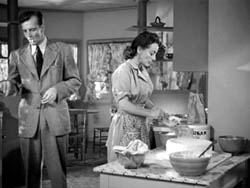
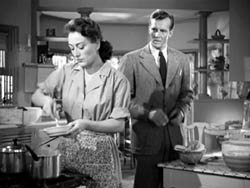
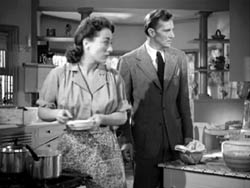
This staging technique is as characteristic of 1940s cinema as…well, as it is of 1930s and 1950s cinema. Let’s hope that some of it finds its way into The Good German. Can he really make ’em like they used to?
I have more comments, especially on Soderbergh’s fascinating remarks on changes in editing, but those are more appropriate to my next installment.
Addendum, 25 January
Owing to a slow and barren rollout, The Good German arrived in Madison last week. I caught it yesterday, so I thought I’d add this postscript.
It’s hard to appreciate as a straight film, it’s so dense and tightly wrapped in an air of pastiche. For the first time in my life, I felt the way students starting to study film tell me they feel: Noticing technique takes away from following the story. I found it hard to engage with the unfolding action because there was always some archaic technique obtruding–a trembling back-projection, a soft-edged wipe, or noirish lighting. I think audience involvement is also hurt by schematic plotting, with the Clooney character getting pretty regularly clobbered by bad guys.
So what about it as a pastiche? I think it fails. It’s cut a bit fast for the period (I clock it averaging about seven seconds per shot), but that’s not the real problem. The photography is too high-contrast for a studio film of that period; on the print I saw, the blacks were fairly rich, but the whites were blasted out and the grays were mostly gone. The editing of the fights is very modern, short and sharp and at some moments almost unreadable. On the whole, shots are closer and compositions less compact than in the sort of 1940s film that Soderbergh seems to be mimicking. These factors are probably due to the fact that he had to shoot in 1.85 and couldn’t stick to the 1.33 proportions of the newsreel-montage credits.
In my blog, I’d hoped that Soderbergh would revive the fluid crosswise staging of the period, but no such luck. Stand-and-deliver rules, with the over-the-shoulder framings and big reaction shots as prominent as in any movie today. Soderbergh also succumbs to the modern habit of ending a scene on a long-shot, which most directors of the time wouldn’t favor.
As for the voice-over narration. Soderbergh knows that the forties saw a lot of experimentation with this technique. But I don’t recall that his variant–each of the three main characters gets a stretch of voice-over in the beginning, middle, and end–has an equivalent at the time. When a 1940s film draws on more than one character’s voice-over, we’re given an overarching narrating situation to frame each one, such as the police interrogation of several witnesses, or the day’s boat trip of Letter to Three Wives. Here, the voice-overs aren’t framed in that way, so the result is more like the free-floating musings we get in The Thin Red Line or a Wong Kar-wai film.
There are some nice trouvailles, though. The lighting in the sewer scene is purty, and it was a clever idea to use an abandoned movie theatre for a rendezvous, though the geography of the space isn’t really exploited much. I enjoyed the transition from the credits’ 1.33 format (complete with dirty projector gate) to the 1.85 one: the first shot in 1.85 is a darkened airplane hanger whose open doorway approximates the squarer ratio. On the whole, though, The Good German seems to me even more dry and cerebral a project than Solaris, a sort of film-school exercise by the deepest-pocketed kid in the class. Fortunately, the Oceans 11 franchise pays for it, but I wish Soderbergh would go back to the less showy genre riffs of The Underneath and Out of Sight.
Originality and origin stories
Kristin here–
In the November 6 issue of Newsweek (also online), Devin Gordon comments on the recent trend in franchise series to throw in a prequel covering an earlier period in the main character’s life. “So-called origin stories—how fill-in-the-blank became fill-in-the-blank.”
At first David and I wondered whether Gordon, like so many film journalists, would go for the easy answer. There are at least two easy answers in the context of popular films, and especially blockbuster franchise films. One, their stories reflect something about the current psyche of the nation. Alternatively, they are symptoms of Hollywood running out of creativity and backbone and going for the tried and true.
The public psyche theory may sound profound at first, but it’s basically a quick way to write a story without knowing much of anything about film history or how the film industry works. There may be all sorts of reasons why a given kind of movie is made at a certain time. We all know about genre cycles. But society is vast and multi-faceted, and it isn’t hard to make any given film seem to “reflect” some aspect of it. Might the vogue for origins stories mirror a widespread desire to return to a more innocent era before 9/11? Bingo, you’re got your hook and can make your deadline. (Don’t get me started on the fact that most big films these days are negotiated, greenlit, planned, and in production for years before they appear, thus presumably reflecting not our own Zeitgeist but one that has come and gone.)
As to Hollywood running out of creativity, there are plenty of people in Tinseltown with great scripts and the desire to make them. We’re living in an age, though, when the big studios are owned by conglomerates. More than ever, the studio decision makers and the investors who buy their stocks keep an eye on the bottom line. Variety’s October 23 front-page story, “Less Dream, More Factory,” is on the layoffs and other cost-cutting measures that the big studios face. (By the way, we aren’t putting links to stories in Variety.com, since it’s a subscription-only site.) So the tactics of producers now must be to focus on exploiting the most popular characters and story premises for their tentpole projects.
Gordon recognizes this and puts his finger on a major reason for the vogue for “origin stories.” The studios have to prolong their most lucrative franchises, which are essentially their owners’ big brands. Yet those franchises can grow formulaic. One way to renew their energy can be to leap back in time.
Gordon opines, too, that “Ironically, playing it safe financially also provides studios with the cover to take creative chances.” He points to the fact that Peter Webber, who is directing Young Hannibal, has only the indie hit Girl with a Pearl Earring to his credit. Similarly, art-house darling Christopher Nolan gave one big franchise a new respectability and audience with Batman Begins and will try to continue to do so with The Dark Knight.
Linking origin stories to the hiring of such filmmakers is perhaps a bit of a stretch. The new Bond film, Casino Royale, the earliest in the order of Ian Fleming’s original novels, shows a younger agent. Much of the flashier high-tech props of recent entries in the series are apparently gone, with a grittier feel to the film. Yet it was directed by Martin Campbell, who also had made an earlier entry, GoldenEye, as well as both the Zorro films.
It’s true that recently Hollywood studios have shown a strange propensity to hire independent or foreign directors to helm entries in franchises. In the wake of his hit Once Were Warriors, New Zealand’s Lee Tamahori was imported and made Die Another Day and xXx: State of the Union. Warner Bros. brought in Mexican director Alfonso Cuarón (Y tu mamá también) to make the third Harry Potter film, presumably because many critics had dubbed the first two, by Chris Colombus, too bland. Perhaps the studios simply see franchises as needing shaking up at intervals. Yet this is part of a larger trend of indie directors suddenly boosted to blockbuster assignments, as when Doug Liman went from Go to The Bourne Identity and Mr. and Mrs. Smith.
An “origin story” in the sense that Gordon is using the phrase is a type of prequel that jumps back far enough to show the protagonist distinctly younger and different from the way he is in the original film or series. It then explains how he changed into that protagonist.
Hong Kong filmmakers are adept at prequels of this sort. God of Gamblers: The Early Years, shows us the source of the protagonist’s lucky ring and his taste for gold-wrapped chocolate, both of which are major motifs in the original God of Gamblers. The case of A Better Tomorrow is more complicated. John Woo and Tsui Hark had intended it to be a stand-alone film, and they made the mistake of killing off the most charismatic character. The film was such a hit, largely on the basis of Chow Yun Fat’s performance as Mark, that A Better Tomorrow II gave Mark a twin brother, Ken, and put Chow back in action. That film’s success led to a prequel to the first film. A Better Tomorrow III traces how the Mark character acquired his fighting skills and his signature costume and habits.
Origin stories are not entirely new to Hollywood, either. As far back as 1974, The Godfather Part II wove in flashbacks to a time well before the first film’s action, tracing Don Corleone’s rise. In 1979, there was Butch and Sundance: The Early Days.
Origin stories can be thought of as expansions of a basic convention of mainstream storytelling: the flashback to crucial formative moments in a character’s life. In that sense, perhaps the quintessential origin story is Citizen Kane. Today, when everything is potentially franchisable, such an early-days sequence can create a series. The prologue of Indiana Jones and the Last Crusade shows young Jones launching upon an adventure that prefigures the man he will become. (In what surely is an inside joke, River Phoenix even acquires Harrison Ford’s chin scar.) That sequence in turn spawned The Chronicles of Young Indiana Jones TV series (“Before the world discovered Indiana, Indiana discovered the world”) and four cable movies.
As a term, “origin stories” was coined by students of mythology, who use it to refer to various ethnic groups’ accounts of the origin of the world. In that case, it didn’t have anything to do with what we now call prequels.
Then the term got taken up in discussions of comic books to identify the sort of thing that Gordon is talking about. Before television, comic books were the ultimate franchise form of the twentieth century. In comic franchises, particularly those centering on superheroes, a book or short series of books might be devoted to an origin story. (Dave Carter’s blog has a lengthy entry on comic-book origin stories, giving examples.) It’s not surprising that one of the main origin films, Batman Begins, came from the comics.
Gordon does not mention another reason why studios might want to continue a franchise by jumping back to the hero’s origins: actors can age too much to continue a role. It’s been over 14 years since The Silence of the Lambs, and Anthony Hopkins could probably not be convincing in another turn as Lecter. Possibly we’ll get a chance to see whether a 60-something (or 70-something at the rate things are going) Harrison Ford can bring audiences in for the on-again-off-again Indiana Jones continuation. Or actors may exit the franchise, as Jody Foster did before Hannibal. Or grow up too quickly, as the Harry Potter kids are doing before our eyes. Or die, as Richard Harris did in the same series, forcing Warners to substitute Michael Gambon as Dumbledore.
But origin stories don’t have these problems. Just get new actors. One thing tentpole franchise films have taught us is that, as strongly identified with a character as a star may become, if the character and premises are even stronger, a new actor will be accepted. It’s happened with Batman, Superman, Bond, and almost did—and could yet–with Spider-Man.
Such stories, however, have their dangers as well. If the audience is devoted to the character as he (and it’s mostly he so far) is, will they care about seeing him as a very different person? If Hannibal Lecter is the middle-aged psychopath we love to hate, do we want to learn that he was once a vulnerable, suffering youth?
Global moviegoing, including Iceland
DB here:
How many screens are showing movies theatrically across the world? What is the global box-office take? How many people go to the movies? What do movie tickets cost in various countries of the world? In what nations do people go the movies most often? Least often?
Comprehensive and reliable information on these matters is hard to come by. Fortunately, there are media research companies that track such information….for a price.
We pay the price, because the information is central to our research. But there’s no reason to keep you in the dark, so herewith some factoids from 2005.
Global box office receipts: $23.6 billion.
This is down from 2004 ($24 billion), but still the second highest ever recorded. Europe and US slumped a bit, but in Asia and the Far East, receipts were up. Markets outside North America yielded about 59% of world box office.
Global admissions: 7.5 billion.
India provides 3.8 billion of that alone! China is relatively thin in theatrical admissions, with only 157 million. Western Europe yields about 850 million, as compared with the USA, with admissions of 1.4 billion.
The big news is that admissions have declined significantly in most countries, often ranging from 5-20 %. Even the USA has seen nearly a 10% drop in admissions. The overall box-office slump isn’t as severe because the dwindling attendance has been offset by a rise in ticket prices and a boost in some countries’ admissions, most notably South Korea (up about 7 %) and China (up nearly 15%).
Global screen count: 149,083.
Nearly 40,000 of these are in China (but many are temporary or occasional venues). The USA has nearly as many screens, at 39,000. But China has 1.3 billion people, while the US has only 300 million. At the other extreme, poor little Tunisia, with 10 million people, has only 22 movie screens.
Screens per million population: Iceland is the leader (about 160 screens per million), followed by Sweden and the US, each with about 130 screens per million head.
The lowest proportions are in Vietnam, Tunisia (no surprise), and Ukraine, with about 1-2 screens per million population.
Average global ticket price (in US dollars): $3.14.
Most expensive ticket: Switzerland ($11.55). Lowest: India, at $.32. US: $6.41.
Visiting the cinema
Most visits per capita: Iceland (4.77 times per year), USA (4.73), Singapore (4.16).
Others: France and Spain (2.9), Belgium (2.1), Japan (1.26), Russia (.55).
Fewest visits per capita: Cuba (.17), Romania (.13), China (.12).
The data aren’t complete for some countries, chiefly those in Africa. Still, the figures are intriguing. Here are a couple of inferences.
North America, chiefly the US and Canada, yields a disproportionate chunk of box office receipts: a whopping 41 %. Why? These countries are at once populous and prosperous. Elsewhere, the most populous countries (e.g., India, China) aren’t as wealthy, and so ticket prices are low. The most prosperous countries, where people can afford high ticket prices, tend to be small ones, like Western European and Scandinavian nations. The US and Canada have the best of both worlds.
Another inference: Some countries are densely screened, with the US being a prime instance. It’s a strategy driven by the idea that each weekend includes must-see movies. So there need to be a lot of screens to accommodate demand for the same films over the same three days. But that’s just the weekend; outside the biggest cities, theatres are virtually empty the rest of the week.
It’s too soon to say if the drop in attendance is temporary or part of a long, slow decline. These patterns tend to fluctuate over several years. In 1995, worldwide attendance was 6.8 billion, so recent years have seen a healthy growth.
There’s a lot else to speculate on here, but let’s not neglect one conclusion. Icelanders really, really like movies.
PS: Send me a photo of an Iceland movie theatre, preferably full of Icelanders, and we’ll add it to this entry.
Thanks to the good people at Screen Digest, and particularly David Hancock’s department. The information above is culled from SD‘s annual profile “Global Cinema Exhibition Trends,” published in October 2006.
Who the devil wrote it? (Apologies to Peter Bogdanovich)
From DB:
Every so often we’re told that the real “author” of a film is the screenwriter. What do we make of this?
I think I first heard this idea in 1966. It was already old then. Publishers had for some time brought out books of screenplays, treating them as literature (e.g., the James Agee scripts) or as the ur-form of the film in the days before home video (John Gassner’s Twenty Best Film Plays). Responding to Andrew Sarris’ auteur theory, Richard Corliss wrote The Hollywood Screenwriters in 1972. The book was organized in a fashion parallel to Sarris’ trailblazing The American Cinema, ranking screenwriters and suggesting their recurring thematic concerns. But it had nothing like the impact of Sarris’s account of directorial differences. Once Corliss became a critic for Time, he did what everybody else did: attributed the goodness or badness of a film primarily to the director and barely mentioned the screenwriter.
Ever since then, the notion has resurfaced periodically, usually with an air of thunderous discovery. David Kipen subtitled his book The Schreiber Theory boldly, too boldly: A Radical Rewrite of American Film History. The idea is recycled in Joe Eszterhas’s new book The Devil’s Guide to Hollywood: The Screenwriter as God! (St. Martin’s Press). Beyond the scurrilous gossip and thumbnail advice he offers, Eszterhas claims that the screenwriter is the key creative individual in movie making. He denounces the auteur theory, which assigns artistic control primarily to the director, and he constantly asserts that no great movie was ever made without a great screenplay.
Eszterhas does grant that when a director writes the script him- or herself, that justifies the auteur theory. But when the director works from a script by another hand, the prime mover isn’t in doubt.
You’re the storyteller, not the director. . . . If anybody in your presence refers to the director as a “storyteller,” deck him (or her).
In musical terms, you are the composer; the director conducts the orchestra.
This idea poses a lot of problems.
Many films need no script. Consider Ballet Mécanique, Oskar Fischinger’s work, Tony Conrad’s Flicker, Ernie Gehr’s Serene Velocity, Andy Warhol’s Haircut, Lewis Klahr’s Two Minutes to Zero Trilogy, and many, many others in the avant-garde or experimental filmmaking tradition. Eszterhas’s claim would apply only to fictional mass market cinema—that is, the movies at the multiplex. But even then there are difficulties.
First, in principle we could have a mainstream movie that was completely unscripted. Maybe the directors and actors and crew cooked up, day by day, a series of scenes in which the dialogue was improvised. Maybe they shot at a 100:1 ratio and carved out of the footage a recognizable, ordinary film. We’d then have something that we’d accept as a passable movie without there ever having been a script.
Granted, this is very unlikely to happen, and it’s probably even more unlikely to result in a good movie. Perhaps the closest existing example is the working method of Wong Kar-wai, who writes his scenes day by day and shoots them more or less off the cuff. Gradually, he compiles enough material to assemble a film. The practice can cause anxieties for his collaborators, and there’s certainly a lot of wasted time and footage, but the results certainly pass muster. Even if you don’t buy the example, it remains possible in principle to make an acceptable mass-market film without a script.
There are more complicated theoretical issues too.
If we all agree that a movie consists of images and sounds, not words on a page, then Eszterhas’ analogy with music fails. In the Western concert tradition, the score captures key features of the identity of a piece. A musical score is written in a more stringent notational system than the language of screenplays. There isn’t a one-to-one relationship between what’s written in the script and what shows up on the screen. The sounds and moving images aren’t specified by the screenplay to the degree that performances of Sibelius’ Fifth Symphony are specified by the score.
The screenwriter writes: “An office.” But the director and the cinematographer and many others must specify how that office looks, the style of the furniture, the way light strikes the surfaces, the position from which the camera sees the action, and hundreds of other factors that shape the image. No one could write all these details into a screenplay. Even if he or she tried, any item could always be construed in a different way when the image is created. Is the desk the shade of brown that the screenwriter envisioned? Are the lampshades the same size?
No prose description of any chunk of reality can uniquely specify the layout of objects and all the patterns of light, color, and shape. By the same logic, no screenplay can exhaustively pre-plan the movie image.
What about dialogue? Much the same holds true as for the image. Even if an actor says the writer’s line word for word as written, it can be delivered in many different ways. And of course facial expression, stance, gesture, and all the other physical components of performance are visual, and can’t be singularly specified any more than our office setting.
Here’s a thought experiment. Give four directors the same script. I think that we intuitively believe that the result would be four substantially different movies, even if all scenes were retained, no new ones were added, and not a line of dialogue was altered. Consider as a rough but intriguing example Michael Mann’s TV movie LA Takedown (1989) redone as Heat (1995). There are enough similarities to allow us to see how different two realizations of a scripted scene can be, even in the hands of the same director.
So the words on the page may be transmuted into images and sounds in an indefinite number of ways. Mass-market film production is a process of constant revision: the shooting transforms the script, and then editing and sound work transform the footage.
Someone could reply that the film script is more like the script for a theatre piece. A play can be realized in many different versions, or productions, but we consider the playwright the true author. And we do call a script a screenplay, a play for the screen. So forget the analogy to music. Maybe the film director is like the stage director, and the screenwriter is the true author. We talk of Shakespeare’s Macbeth in, say, Jonathan Miller’s production, so why don’t we speak of Joe Eszterhas’s Showgirls in Paul Verhoeven’s production?
Again, though, we don’t need a script to put on a theatre piece. There are improvised plays, standup comedy routines that grew organically without ever being committed to paper, and commedia dell’arte performances that rely on tradition, not playscripts. Further, for many traditions, the unique identity of a play rests in its text, which must be followed more or less strictly. You can stage Macbeth on the flying trapeze or underwater, and it’s still Macbeth. But if you rewrite the dialogue or add scenes and characters, you’re not doing Shakespeare’s Macbeth any more. Staging a play doesn’t revise the script, as filmmaking does, but rather embodies it.
A movie script can’t uniquely identify what image or noise or passage of music should be presented on the screen. A play script can’t determine every detail of production either, but in many theatrical traditions the script has become the sine qua non of the production. What is inviolate is the text, the speeches; the director has some leeway in handling the stage directions.
A screenplay isn’t a blueprint or road map, let alone something like a musical score. It’s not even as integral as a play text. At best it’s an approximation, a set of suggestions. To borrow from Pirates of the Caribbean: It’s more in the nature of guidelines, really.
Making a film in the mass-market cinema is a series of constant revisions and rethinkings. One script may be revised by another screenwriter, and the result of that may be revised by a team of other writers. By the time The Script reaches the shooting phase of production, it’s often already a collective product. The revision process continues right to the end. Anything in the shooting script may be tossed out if something more fitting is discovered in the course of shooting, editing, and sound design.
In many cases the person supervising such discoveries is the director. This isn’t to deny writers an important role in the creation of a film. All participants contribute something, and scriptwriters contribute a lot. But it seems that in movies made the Hollywood way, the role of the director is in principle the crucial one in coordinating all the inputs and creating something coherent.
In practice, of course, the role may be filled by many individuals. For any particular case, the director may not have the ability or authority to fill the role, and other individuals can assume it. In such cases, we could say that the producer took over when the director left the project, or the star grabbed control of the scene from the director, and so on.
In fact, we do tend to say such things. Which suggests that deep down, there’s a little bit of auteurist in all of us.













